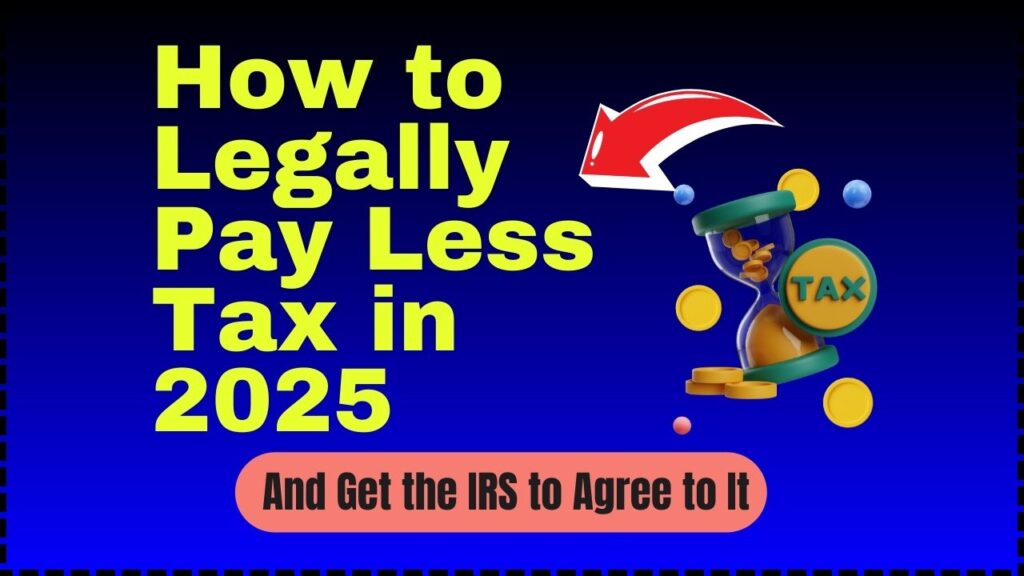
How to Legally Pay Less Tax in 2025: Paying taxes is part of adult life, but it doesn’t mean you have to pay more than your fair share. With smart planning, you can legally pay less tax in 2025 and ensure that the IRS is completely on board. Whether you’re a salaried professional, business owner, or retiree, there are legal tools and strategies available to reduce your taxable income and optimize your financial outcome. In this guide, we’ll explore expert-backed methods to lower your tax burden using IRS-approved approaches. From maximizing retirement contributions to leveraging tax credits and smart investments, these strategies are designed to benefit both the average taxpayer and seasoned professionals.
How to Legally Pay Less Tax in 2025
The IRS provides numerous legal ways to reduce your taxes — it’s just a matter of knowing where to look and acting in time. By taking advantage of retirement plans, HSAs, educational savings accounts, and smart investment strategies, you can significantly lower your tax bill in 2025. Tax planning isn’t just for the wealthy. Whether you’re earning $50,000 or $500,000, there are strategies to help you keep more of what you earn.
| Strategy | Details |
|---|---|
| Maximize Retirement Contributions | 401(k) limit: $23,500; IRA limit: $7,000; Catch-up contributions for 50+: $7,500 (401(k)), $1,000 (IRA) |
| Use Health Savings Accounts (HSAs) | Contribution limits: $3,850 (individual), $7,750 (family); $1,000 catch-up for 55+ |
| Standard Deduction (2025) | $15,000 (single), $30,000 (married filing jointly) |
| Tax-Loss Harvesting | Offset capital gains; up to $3,000 deductible against ordinary income |
| 529 Education Savings Plans | Tax-free growth for education expenses; some states offer deductions |
Understanding the 2025 Tax Landscape
The IRS adjusts tax rules and thresholds annually based on inflation and economic shifts. For 2025, key updates include:
- Standard Deduction: $15,000 for single filers and $30,000 for married couples filing jointly.
- Marginal Tax Rates: Top rate remains 37% for incomes over $626,350 (single) and $751,600 (married).
- Inflation Adjustments: Affecting thresholds for tax brackets, deductions, and credits.
Understanding these numbers helps guide your planning and ensures you make the most of legal tax benefits.
How to Legally Pay Less Tax in 2025?
1. Maximize Retirement Contributions
Saving for retirement isn’t just smart for your future — it’s one of the easiest ways to shrink your tax bill today. Here’s how:
- 401(k), 403(b), and 457 Plans: Contribute up to $23,500 in 2025. If you’re 50 or older, add another $7,500.
- Traditional IRA: $7,000 annual limit; add $1,000 if you’re 50+.
- Roth IRA: Contributions aren’t deductible, but withdrawals are tax-free in retirement.
Example: A 52-year-old contributing to both a 401(k) and a traditional IRA could reduce taxable income by up to $31,000.
2. Utilize Health Savings Accounts (HSAs)
If you have a high-deductible health plan (HDHP), an HSA is a goldmine of tax savings:
- Contributions are tax-deductible.
- Funds grow tax-free.
- Withdrawals for medical expenses are also tax-free.
In 2025, individuals can contribute $3,850 and families $7,750. People 55 and over can contribute an extra $1,000.
3. Optimize Deductions and Credits
There are two main types of deductions — standard and itemized. Choose the one that offers more savings:
- Itemize if your mortgage interest, state/local taxes, and charitable donations exceed the standard deduction.
- Child Tax Credit: Worth up to $2,000 per child under 17; subject to income limits.
- Charitable Donations: Consider “bunching” gifts into one year to exceed the standard deduction.
4. Implement Investment Strategies
Investing isn’t just about building wealth — it can help you save on taxes too.
- Tax-Loss Harvesting: Offset gains by selling underperforming assets. You can deduct up to $3,000 in losses annually.
- Long-Term Capital Gains: Assets held longer than a year are taxed at a lower rate (0%, 15%, or 20%).
- Municipal Bonds: The interest is usually exempt from federal (and sometimes state) income taxes.
5. Consider Income Shifting and Timing
These methods work particularly well for business owners or families:
- Income Shifting: Move income-producing assets to family members in lower tax brackets.
- Defer Income: Push a bonus or invoice into next year if you expect to be in a lower tax bracket.
- Accelerate Deductions: Pay mortgage interest or property taxes before year-end.
6. Leverage Education Savings Plans
Education costs are rising — but tax-advantaged accounts can help:
- 529 Plans: Contributions grow tax-free and can be used for tuition, books, and more. Many states offer a deduction for contributions.
- Coverdell ESAs: Limited to $2,000/year per beneficiary, but also tax-free for qualified expenses.
7. Work with Tax Professionals
Tax planning isn’t one-size-fits-all. Working with a certified public accountant (CPA) or enrolled agent (EA) ensures that you:
- Identify the most relevant deductions and credits.
- Avoid errors that trigger audits or penalties.
- Receive up-to-date advice based on current IRS rules.
IRS Tax Refunds 2025: Find Out the Exact Date Your Money Hits Your Bank
Who Will Be Affected by the 40% Tax Bracket? IRS Releases 2025 Tax Adjustments!
Frequently Asked Questions (FAQs)
Q1: What is the best way to reduce taxes quickly?
Max out retirement contributions and fund an HSA if you’re eligible. These actions directly reduce taxable income.
Q2: Can I deduct home office expenses in 2025?
Yes, if you’re self-employed. W2 employees typically cannot unless special conditions apply post-2020.
Q3: Are Roth IRA contributions tax-deductible?
No, but qualified withdrawals during retirement are tax-free.
Q4: Is it legal to shift income to a child?
Yes, as long as it’s legitimate. For example, hiring your child in your business at a reasonable wage is acceptable.
Q5: How do I know if I should itemize?
Compare your potential itemized deductions to the standard deduction. Use IRS Form 1040 Schedule A or tax software to help estimate.








